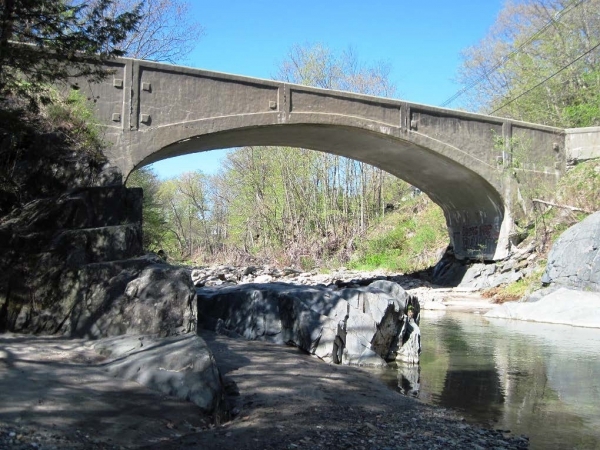NEWFANE — Because of funding shortages, replacement of the crumbling Arch Bridge got pushed back a few years. According to current plans, construction should begin in the summer of 2021.
Carolyn Carlson, senior project manager with the Agency of Transportation, presented the plans, and the new timeline, at the June 5 Selectboard meeting.
Bridge #12 - the Arch Bridge - was constructed in 1908 and is currently rated “poor” by the AOT. The 76.5-foot span has a cracked foundation, and the lane, shoulder, and approach widths are too narrow for traffic volume, design speed, and roadway classification, according to the Agency.
The bridge's railing, which the AOT considers too short, has failed.
The total project cost, including engineering and contingencies, is $2,241,181. Newfane's share is 5 percent, or $112,059.
The schedule is pushed back, Carlson said, because of a lack of state funding to match federal money. If funding comes in earlier - or if Newfane can pay for more of it - the project could be ready to go in 2019, Carlson said.
But, she said, “I don't think that's going to happen.”
AOT engineers are working on the project's final design, Carlson said. Beginning next June, they will begin applying for permits, finish up the plans, get rights-of-way, and start the utilities relocations.
In August 2020, they will put the project out to bid, then begin construction in the summer of 2021. The project, once started, should take eight months to complete, including an estimated 20-week bridge closure.
The AOT considers the bridge safe for vehicular travel, but signs warning pedestrians to stay away from under the bridge appear on both sides of the span.
For the last few years, AOT officials have held numerous public hearings with the Selectboard to hash out what kind of span should replace the Arch Bridge. Because of its historical nature - it is the oldest concrete arch in the state - design options are limited.
“The new bridge will replicate the existing historic arch as closely as possible,” except for the railing, Carlson told townspeople.
According to the AOT, the final design is a “full bridge replacement with a new reinforced concrete closed spandrel elliptical arch,” and the new bridge's estimated life will be 80 years.
Most of the debate in the past few years has been about the width of the bridge, the number of lanes crossing it, and how to ensure safety, ease of crossing, and traffic calming across the bridge and into Williamsville village.
The new plans call for a 28-foot wide bridge, striped for single-lane use, with a posted 25 mph speed limit. The width can accommodate two lanes for future traffic patterns or in an emergency. “That was the consensus from our last visit to Newfane,” Carlson said.
“Traffic calming was one of the biggest issues” in the project, Carlson said.
The center travel lane is 12 feet wide with two 7-foot shoulders, which will make the bridge safer for bicyclists. But, if town officials want to keep it that way, they have to maintain the striping at least every other year, if not more frequently, Carlson warned.
Plans include changing the traffic pattern for motorists approaching the bridge, and the “final determination” was safety, Carlson said. Drivers coming up Depot Road will see a sign warning them of a one-lane bridge, then a yield sign. Drivers coming from Dover Road or Grimes Hill Road will have stop signs, giving drivers crossing the bridge from Depot Road the right of way - though they must yield to oncoming traffic.
Other improved safety measures for the new bridge and its approaches include a railing that meets current standards, and a slight increase in the grade for better visibility.
To accommodate town officials' request for a full bridge closure throughout the bridge's replacement, the AOT planned for a 20-week closure, although Carlson said that is an estimate and could change by a few weeks, plus or minus.
The detour will bring travelers up Grimes Hill Road, and it and Dover Road will be single-lane only for the duration, with traffic signals at each end.
The single-lane configuration during construction is necessary, Carlson said, because “this is such a tight working space that it'll be very difficult to build this bridge” without the extra space for excavation of the bridge and the fill beneath and around it.
“Traffic's going to be very slow” during construction, Carlson said, “but if we don't do this, I'm 95 percent sure we can't do the project.”
Carlson invited questions and feedback, and said there will be more public meetings. She told townspeople a project manager who can answer questions will be on-site for the duration of construction as well.
